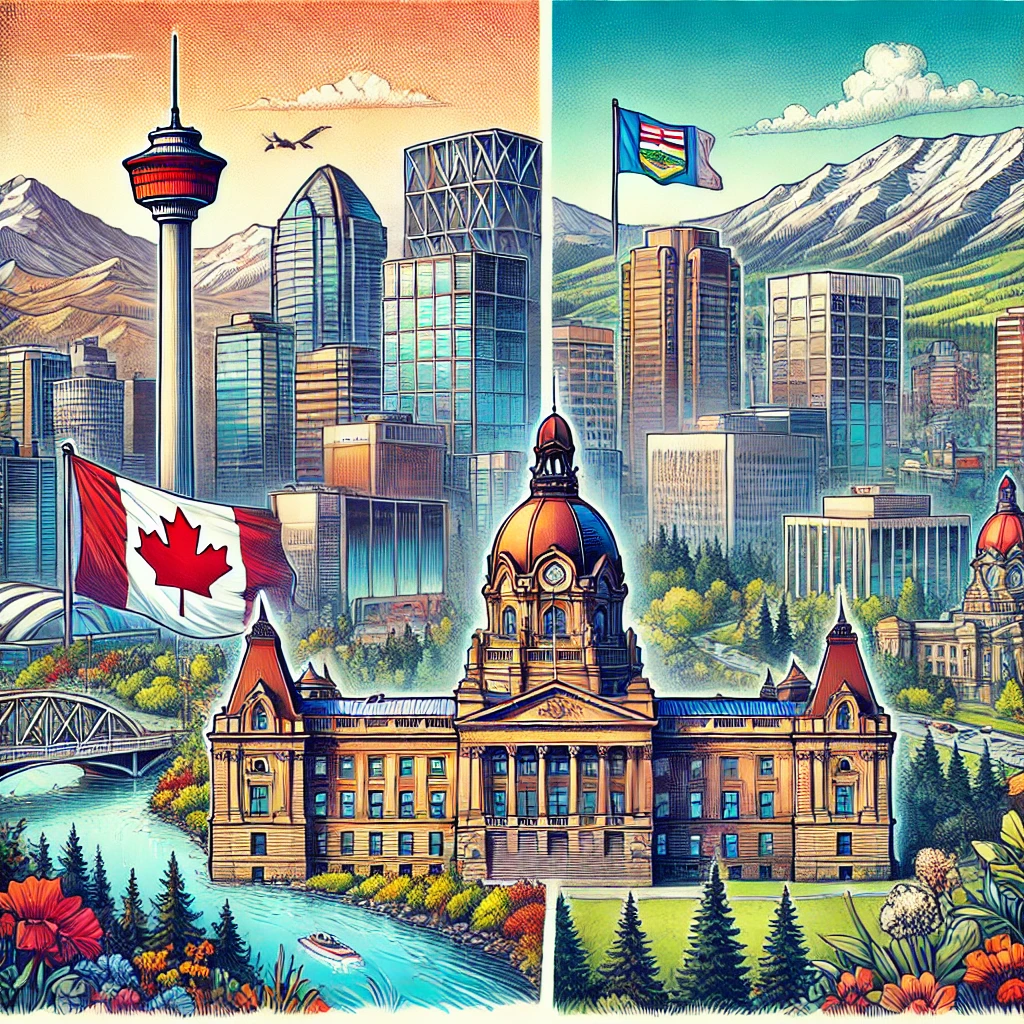Table of Contents
Introduction: Alberta’s Dynamic Duo
Alberta, a province known for its stunning landscapes and robust economy, is home to two of Canada’s most vibrant cities: Calgary and Edmonton. Each city possesses a unique character that reflects the diverse culture, history, and lifestyle of the region. As the largest cities in Alberta, Calgary and Edmonton not only serve as provincial capitals for economic activity but also play a critical role in shaping the cultural identity of Canada as a whole.

Calgary, often recognized for its spirited Western culture and proximity to the Rocky Mountains, is renowned for its annual Calgary Stampede, attracting visitors from around the globe. This city boasts a thriving business sector and modern infrastructure complemented by a rich tapestry of arts and recreational opportunities. Whether it’s the breathtaking view from the Calgary Tower or the diverse culinary scene, Calgary encapsulates a dynamic blend of urban living and natural beauty.
In contrast, Edmonton, the provincial capital, is often described as a cultural hub with its numerous festivals, art galleries, and museums. The iconic West Edmonton Mall, which features a range of entertainment options, is one of the largest shopping centers in North America. Additionally, Edmonton is known for its diverse communities and its commitment to fostering multiculturalism. Its rich history, reinforced by the North Saskatchewan River valley’s picturesque outdoor spaces, adds an exciting dimension to the city.
This blog post aims to delve deeper into the distinctive attributes of both Calgary and Edmonton. From their cultural offerings and attractions to considerations of lifestyle and community engagement, we will provide a clear comparison of Alberta’s dynamic duo. Ultimately, our exploration will assist readers in determining which city aligns more closely with their interests and preferences.
A Glimpse into History: Calgary and Edmonton
Calgary and Edmonton, two prominent cities in Alberta, Canada, have distinct historical narratives that have shaped their identities and development. Calgary was founded in 1875 as a North-West Mounted Police fort, aimed at curbing the illegal whiskey trade in the region. Its strategic location near the confluence of the Bow River and Elbow River made it an essential outpost for the burgeoning Canadian frontier. The city experienced rapid growth following the completion of the Canadian Pacific Railway in 1883, which facilitated trade and population movement. By the early 20th century, Calgary had developed a reputation as a hub for ranching and agriculture, leading to its nickname, the “Gateway to the Canadian Rockies.”
Conversely, Edmonton’s origins lie in the fur trade, with its establishment as Fort Edmonton in 1795 by the Hudson’s Bay Company. This trading post was integral to the British fur trade route and contributed significantly to the economic development of the region. Over the years, Edmonton grew steadily, particularly during the gold rush in the 1890s, which attracted a wave of immigrants seeking fortune. The city’s incorporation in 1904 marked a turning point in its development, leading to investments in infrastructure and commerce that established it as a major urban center. The discovery of oil in Leduc in 1947 further propelled Edmonton’s growth, as it became the cornerstone of Alberta’s oil and gas industry.
Both cities have been influenced by notable figures throughout their history. For Calgary, the influence of ranchers like Pat Burns, who was pivotal in developing the cattle industry, played a significant role in its early economy. Edmonton boasts historical figures like J. P. McKinnon, a former mayor who contributed to urban planning initiatives during the city’s formative years. Over the decades, trade, industry, and the abundance of natural resources have been instrumental in driving the economic and social evolution of both cities, ultimately forging unique identities that continue to thrive today.
Cultural Landscape: Arts, Festivals, and Entertainment
Calgary and Edmonton, two prominent cities in Alberta, each possess a rich cultural landscape that highlights their unique identities, artistic endeavors, and vibrant communities. The arts scene in both cities showcases a plethora of opportunities for residents and visitors alike, ranging from music and theater to visual arts and annual festivals. In Calgary, the Calgary Stampede stands out as a significant event, attracting hundreds of thousands of attendees each year. This iconic celebration, often referred to as “The Greatest Outdoor Show on Earth,” not only features rodeo competitions but also showcases a variety of musical performances, cultural displays, and artisan booths, reflecting the city’s heritage and artistic spirit.
Edmonton, on the other hand, is widely known for the Edmonton International Fringe Theatre Festival, which is the largest fringe festival in North America. This festival provides a platform for local and international artists to present diverse theatrical performances, thereby promoting artistic expression and cultural exchange. The festival emphasizes inclusivity and creativity, showcasing everything from drama and dance to comedy and improv. It serves as an essential gathering point for artists and audiences, underscoring Edmonton’s vibrancy in the performing arts.
Both cities also boast numerous art galleries and cultural institutions that display a wide range of artistic expressions. Calgary offers venues like the Art Gallery of Calgary and the Glenbow Museum, while Edmonton is home to the Art Gallery of Alberta and the Royal Alberta Museum. These galleries not only host exhibitions but also run educational programs that engage the community and promote awareness of Alberta’s cultural heritage.
In summary, while both cities hold distinct cultural events and artistic communities, their commitment to celebrating arts and entertainment demonstrates a shared appreciation for creativity and cultural diversity. The continuous efforts by both municipalities to elevate their cultural offerings undoubtedly enrich the lives of their citizens and enhance the overall experience of visitors.
Urban Vibe: Neighborhoods and Community Life
Calgary and Edmonton, two of Alberta’s most notable cities, each showcase unique urban vibes influenced by their diverse neighborhoods and community life. In Calgary, the neighborhoods range from the vibrant, artsy districts of Inglewood and Kensington to the family-oriented suburbs like Tuscany. These areas collectively reflect a mix of modern urban living and historical charm, offering residents access to boutique shops, coffee houses, and green spaces. Inglewood, for example, is renowned for its eclectic shops and cultural festivals, fostering a sense of community that attracts both locals and tourists alike.
In contrast, Edmonton’s neighborhoods, such as Old Strathcona and St. Albert, emphasize community engagement and cultural preservation. Old Strathcona is particularly known for its historic buildings and lively farmers’ market, serving as a hub for social gatherings and events. The city’s extensive bike paths and parks promote an active lifestyle, providing residents with ample opportunities for outdoor recreation. Similarly, communities like Terwillegar showcase family-friendly amenities, including play areas and schools, contributing to Edmonton’s reputation as a welcoming city for families.
Both cities celebrate their culture through numerous community events, from Calgary’s Stampede to Edmonton’s Folk Music Festival. These events not only highlight local talent but also strengthen community bonds, drawing residents into shared experiences. Furthermore, recreational facilities, such as swimming pools, sports complexes, and arts centers, are integral in promoting active lifestyles and interaction among residents. In essence, while Calgary may appear more trend-driven with its focus on urban development and nightlife, Edmonton embraces a more laid-back, community-focused atmosphere that emphasizes collective engagement and cultural enrichment.
Outdoor Adventures: Nature and Recreation
Calgary and Edmonton, two vibrant cities in Alberta, offer a plethora of outdoor activities that cater to nature enthusiasts throughout the year. Both cities provide access to scenic parks, extensive hiking trails, and close proximity to the breathtaking Rocky Mountains as well as serene river valleys. This makes them ideal locations for those who enjoy engaging with nature.
In Calgary, the expansive Fish Creek Provincial Park stands out as one of North America’s largest urban parks. Spanning over 13 square kilometers, it features a diverse range of ecosystems and numerous trails suitable for hiking, cycling, and birdwatching. The city also boasts the Olympic Park, which is perfect for both winter sports and summer activities, offering opportunities for skiing, snowboarding, and mountain biking. Furthermore, Calgarians often enjoy access to the Bow River, which is ideal for kayaking, paddleboarding, or simply enjoying a relaxing day by the water.
On the other hand, Edmonton is home to the North Saskatchewan River Valley, a majestic natural area offering over 160 kilometers of trails for hiking and biking, making it one of the largest urban park systems in North America. The city’s commitment to environmental conservation is evident in its numerous parks, including the beautiful Hawrelak Park, which hosts various cultural events throughout the year. Additionally, Edmonton’s winter sports offerings, such as those available at the famous Snow Valley Ski Club, allow residents and visitors to participate in skiing and snowboarding activities.
Comparatively, while both cities boast impressive outdoor facilities, Calgary may offer more immediate access to the Rocky Mountains, an advantage for those seeking mountain experiences. Edmonton, however, excels in urban nature with its vast river valley trail system. Ultimately, the preference for outdoor adventures may depend on individual interests, as both cities create ample opportunity for residents and tourists alike to immerse themselves in the great outdoors.
Culinary Delights: Dining and Local Cuisine
The culinary landscape in Alberta is as diverse as its culture, and both Calgary and Edmonton boast an array of dining options that reflect their unique character. Calgary is often celebrated for its meat-centric dishes, particularly its renowned beef, with establishments like Charcut Roast House and the historical Butchery known for serving exceptional steak. This city’s vibrant food scene is well complemented by its burgeoning farm-to-table movement, which emphasizes local ingredients sourced from the surrounding prairies. Furthermore, the Calgary Stampede not only showcases rodeo events but also features food vendors presenting traditional Western fare, from deep-fried delicacies to barbecue classics.
Edmonton, on the other hand, embraces a more eclectic palate influenced by its multicultural population. The city is home to several diverse culinary offerings, ranging from authentic Ethiopian restaurants like Al-Hasanat to a vibrant selection of Asian fusion eateries. The annual Taste of Edmonton festival highlights the city’s gastronomic diversity, allowing patrons to sample dishes from various local restaurants, promoting culinary innovation. Additionally, the popular Old Strathcona Farmers’ Market serves as a hub for local vendors, showcasing fresh produce, artisanal cheeses, and gourmet products that embody the essence of Alberta’s agriculture.
The thriving food culture in both cities underscores Alberta’s rich agricultural heritage. Calgary’s commitment to showcasing local beef and the province’s bountiful resources is evident in its dining selections, while Edmonton’s culinary scene reflects a global influence, demonstrating the city’s welcoming embrace of various cultures. From farmer’s markets brimming with fresh produce to vibrant restaurants that serve celebrated local and international dishes, both cities continue to evolve, making the choice of where to dine just as vibrant as the culinary landscapes themselves.
Economic Opportunities: Job Market and Business Climate
Calgary and Edmonton, two major cities in Alberta, each offer distinct economic landscapes shaped by their industries and job markets. Calgary is renowned for its oil and gas sector, serving as a hub for energy companies and related services. This city has a robust job market, particularly in engineering, environmental management, and finance, driven by the ongoing demand for skilled professionals in the energy industry. Additionally, Calgary has diversified its economy, with growing sectors in technology, logistics, and creative industries, fostering a dynamic environment for job seekers.
On the other hand, Edmonton’s economy is traditionally anchored in the public sector, given its status as the capital of Alberta. The city provides numerous employment opportunities in government services and education, contributing to a stable job market. Furthermore, Edmonton has made significant strides in diversifying its economy, with key sectors including healthcare, technology, and manufacturing. The city has successfully cultivated a reputation for fostering innovation, attracting startups and established businesses alike, thus enhancing its entrepreneurial climate.
When evaluating the cost of living, Calgary generally has a higher overall cost, particularly in housing, though it also offers higher average salaries which can mitigate this factor for many individuals. Conversely, Edmonton tends to have more affordable housing options, making it an appealing choice for families and younger professionals seeking to maximize their disposable income.
Ultimately, the economic drivers of each city will influence an individual’s decision to relocate or visit. Calgary’s energy-driven jobs may attract those seeking lucrative positions and advancement, while Edmonton’s public sector and growing innovation sectors might appeal to those valuing stability and community development. The entrepreneurial environment in both cities also plays a significant role, allowing businesses to thrive and individuals to explore diverse career paths.
Transportation and Connectivity: Getting Around
Transportation plays a crucial role in the overall connectivity and accessibility of a city. In Alberta, both Calgary and Edmonton boast comprehensive transportation infrastructures, yet they each exhibit unique characteristics that set them apart. Understanding these differences can aid residents and visitors alike in choosing the best means of getting around.
Calgary’s public transit system, known as Calgary Transit, includes an extensive network of buses and a light rail system, affectionately called the CTrain. The CTrain operates efficiently throughout the city, providing rapid access to key areas, including downtown and the northern and southern suburbs. Its two lines significantly ease commutes and contribute to the city’s high level of accessibility. Furthermore, Calgary Transit offers convenient services such as HandyBus for those with mobility challenges. The city’s road networks are well-structured, with major thoroughfares connecting to nearby regions, which is beneficial for those traveling to neighboring areas.
On the other hand, Edmonton’s public transportation is supported by the Edmonton Transit Service (ETS), which includes an integrated bus system and the light rail transit (LRT) network. The LRT has been expanding steadily and currently links various neighborhoods to downtown Edmonton. While the bus services are generally reliable, transit users in Edmonton often report longer wait times compared to those in Calgary. However, the city’s road network is notable for its straightforward layout, making navigation relatively easy. Accessibility to key amenities and attractions is well-planned, although ongoing urban development may introduce temporary complexities for commuters.
In conclusion, both Calgary and Edmonton offer robust transportation options. Calgary’s CTrain system is frequently praised for its efficiency, while Edmonton’s expanding LRT is gaining traction. Ultimately, your choice of city may depend on personal preferences regarding public transit and road accessibility.
Conclusion: Choosing Your Alberta Adventure
In exploring the vibrant cities of Alberta, Calgary and Edmonton undeniably present unique offerings that cater to a variety of preferences and interests. Calgary, with its modern feel, is renowned for its proximity to the stunning Rocky Mountains, providing ample opportunities for outdoor activities and adventure. The city’s westward spirit is further reflected in its diverse culinary scene, flourishing arts community, and lively festivals such as the Calgary Stampede, which draws visitors from near and far.
On the other hand, Edmonton, the capital of Alberta, boasts a rich cultural tapestry that resonates with history, creativity, and charm. It is home to a multitude of museums, galleries, and theaters, making it a cultural hub for those interested in the arts. Notably, the city’s extensive river valley park system offers a vast network of trails and parks, perfect for those who appreciate nature without straying far from an urban environment. Edmonton also hosts various festivals throughout the year, providing residents and tourists alike with dynamic experiences that reflect the city’s warm and welcoming ambiance.

When deciding between Calgary and Edmonton, it is crucial to consider personal preferences and lifestyle choices. Whether one is drawn to Calgary’s vibrant skyline and proximity to outdoor adventures or Edmonton’s rich cultural scene and local hospitality, both cities offer compelling reasons to visit or call them home. Ultimately, Alberta’s charm is amplified by the genuine hospitality found in each location, ensuring that residents and visitors alike will find a diverse array of experiences. In essence, your Alberta adventure awaits, shaped by your interests and the vibrant offerings of Calgary and Edmonton.





